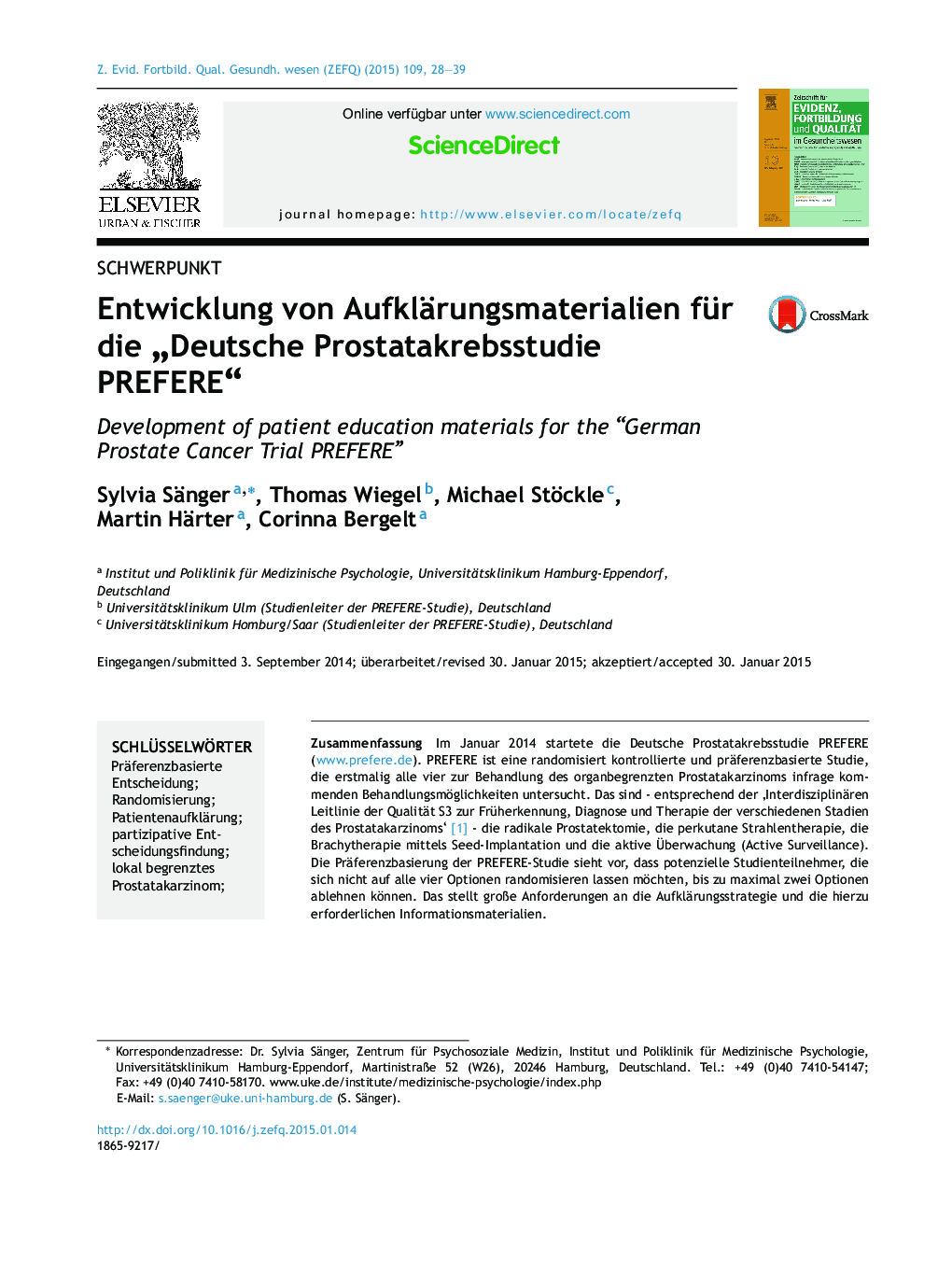| Article ID | Journal | Published Year | Pages | File Type |
|---|---|---|---|---|
| 1093990 | Zeitschrift für Evidenz, Fortbildung und Qualität im Gesundheitswesen | 2015 | 12 Pages |
ZusammenfassungIm Januar 2014 startete die Deutsche Prostatakrebsstudie PREFERE (www.prefere.de). PREFERE ist eine randomisiert kontrollierte und präferenzbasierte Studie, die erstmalig alle vier zur Behandlung des organbegrenzten Prostatakarzinoms infrage kommenden Behandlungsmöglichkeiten untersucht. Das sind - entsprechend der ‚Interdisziplinären Leitlinie der Qualität S3 zur Früherkennung, Diagnose und Therapie der verschiedenen Stadien des Prostatakarzinoms‘ [1] - die radikale Prostatektomie, die perkutane Strahlentherapie, die Brachytherapie mittels Seed-Implantation und die aktive Überwachung (Active Surveillance). Die Präferenzbasierung der PREFERE-Studie sieht vor, dass potenzielle Studienteilnehmer, die sich nicht auf alle vier Optionen randomisieren lassen möchten, bis zu maximal zwei Optionen ablehnen können. Das stellt große Anforderungen an die Aufklärungsstrategie und die hierzu erforderlichen Informationsmaterialien.Zur Patientenaufklärung im Rahmen der PREFERE-Studie waren Materialien (Broschüre und Patientenvideo) zu entwickeln, die Patienten ausgewogen und leitlinienbasiert über ihre Erkrankung und die Behandlungsoptionen informieren, über die Notwendigkeit einer Randomisierung und insbesondere über die PREFERE-Studie aufklären und die individuelle Präferenz- und partizipative Entscheidungsfindung zur Studienteilnahme unterstützen.Die Entwicklung der Materialien erfolgte in einem strukturierten, iterativen Verfahren basierend auf einer vorangegangenen Literaturrecherche. An der Entwicklung und Testung der Patientenbroschüre und des Patientenvideos waren sechs Fokusgruppen mit insgesamt 40 Teilnehmern aus drei verschiedenen Selbsthilfegruppen, Betroffene, die keiner Selbsthilfegruppe angehören, gesunde Männer sowie als Experten die Mitglieder des Steering Commitees der PREFERE Studie und eine Fokusgruppe mit 18 Urologinnen und Urologen beteiligt.Mittels Fragebogen und ausführlicher Diskussion wurden die Verständlichkeit und Eignung von Patientenbroschüre und Video zur Präferenz- und Entscheidungsfindung zur Teilnahme an der PREFERE-Studie getestet. Die Ergebnisse dieser Laien-Bewertungen flossen in die abschließende Überarbeitung ein.Für die Ärztinnen und Ärzte wurde eine Gesprächshilfe erarbeitet, die wesentliche Aspekte der PREFERE-Patientenaufklärung enthält. Das Vorgehen bei der Aufklärung sowie die Patientenaufklärungsmaterialien sind Gegenstand einer Kurzschulung für niedergelassene Urologen und Strahlentherapeuten, die deutschlandweit durchgeführt wird.Der Beitrag beschreibt das methodische Vorgehen bei der Erstellung der beschriebenen Materialien. Inwieweit die Patientenaufklärung durch die behandelnden Ärzte und die Patientenaufklärungsmaterialien die Entscheidung zur Teilnahme an der PREFERE-Studie tatsächlich beeinflusst hat, ist Gegenstand einer Befragung im Rahmen der Lebensqualitätserhebungen nach erfolgter Behandlung bzw. Randomisation (im Fall von Active Surveillance) während der Laufzeit von PREFERE.
SummaryThe German prostate cancer study PREFERE (www.prefere.de) started in January 2014. It is the first randomised controlled and preference-based trial to investigate all four options available for the treatment of organ-confined prostate cancer. According to the “Interdisciplinary evidence-based S3 guideline for the early detection, diagnosis and treatment of the different stages of prostate cancer” [1], these options include: radical prostatectomy, external radiotherapy, brachytherapy and active surveillance. In the context of PREFERE preference-based means that potential study participants who do not agree to being randomised into all four treatment arms can maximally refuse two treatment arms. This poses a big challenge to the patient education strategy employed and the information material it requires.In order to inform patients in the context of the PREFERE trial patient education materials (patient leaflet and video) had to be designed that provide patients with balanced and guideline-based information about the disease and the treatment options available, about the need for randomisation and, in particular, about the PREFERE trial and support their individual preference finding and shared decision making for participating in the trial.An iterative structured approach was used to develop the information materials on the basis of a previous literature search. Six focus groups with a total of 40 participants from three different self-help groups, affected men that do not belong to a self-help group, healthy men as well as experts, the members of the steering committee of the PREFERE trial and a focus group consisting of 18 male and female urologists were involved in the development and testing of both the patient information leaflet and the patient video.Both the patient information leaflet and the video supporting preference finding and decision making for participating in the PREFERE trial were tested for understandability and suitability by using a questionnaire and conducting a comprehensive discussion. The results of these lay evaluations have been included in the final revision.Also, a communication resource for physicians has been created comprising all the essential aspects of the PREFERE patient education materials. A short course conducted all over Germany will focus on the process of patient teaching as well as patient education materials.Whether and to what extent the decision for participating in the PREFERE trial has actually been influenced 1) by what the treating physicians communicated to the patient and 2) by the patient education materials used is one of the subjects of a quality of life survey that will be conducted following treatment or – in the case of the active surveillance option – after randomisation during the PREFERE trial.
